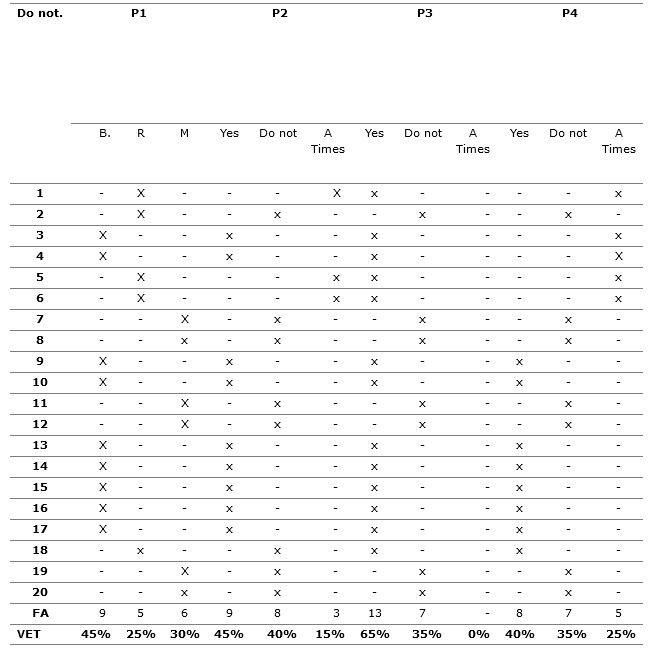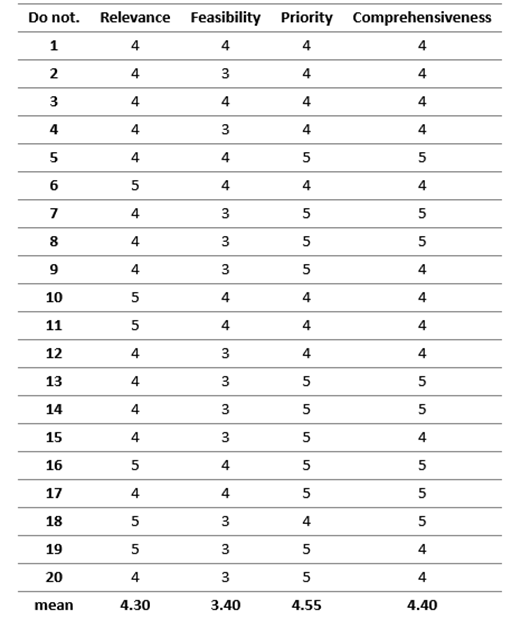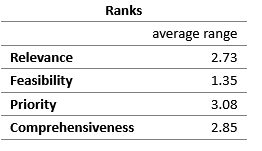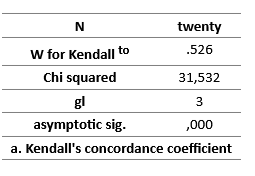Meu SciELO
Serviços Personalizados
Artigo
Indicadores
-
 Citado por SciELO
Citado por SciELO
Links relacionados
-
 Similares em
SciELO
Similares em
SciELO
Compartilhar
Podium. Revista de Ciencia y Tecnología en la Cultura Física
versão On-line ISSN 1996-2452
Rev Podium vol.17 no.2 Pinar del Río maio.-ago. 2022 Epub 05-Ago-2022
Original article
Systematic self-defense training at the Naval High School
1Universidad de las Fuerzas Armadas-ESPE. Quito, Ecuador.
Self-defense in the Naval Force is one of the fundamental competencies of the military professional, the improvement of the mastery process in mixed martial arts requires systematic diagnoses, evidence of scope and limitations and, therefore, making the right decisions to improve the process. In this sense, it was proposed as the purpose of the research: to diagnose needs in the systematic self-defense of the Higher Naval School. The research is exploratory with a descriptive-explanatory and correlational approach; selection is made under an intentional sampling of 20 naval officers. These respond to closed surveys that will justify the prospective design of a future intervention process. The self-assessment of the specialists shows that 40% have a Good rating in mastering karate-do, boxing and judo techniques and 30 % a Bad rating. These values indicate that they are similar during the correct application of karate-do techniques (45 %: Good; 15 %: Bad), Boxing (65 %: Good; 0%: Bad) and Judo (40 %: Good; 25 %: Bad), while the indicators Relevance (4.30 points), Feasibility (3.40 points), Priority (4.55 points) and Comprehensiveness. (4.40 points). These values justified the need to implement an intervention process to improve self-defense in sailors. In the study, an acceptable concordance prevails among the specialists (0.526). Consultation with specialists shows the need to implement a systematic self-defense training process at the Naval High School. The indicators of relevance, feasibility, priority and comprehensiveness are presented as positive in the design of a prospective process to provide professional improvement to Ecuadorian naval personnel in the aspect of self-defense.
Key words: Self-defense; Systematic training; Naval force.
INTRODUCTION
In the self defense of the professional of the naval forces, combats are carried out, multiple actions on sea and land, where several people of different weights and sizes can attack, who use different attack tools. Within these weapons, bladed and firearms of different calibers are included (Mullerson, 2019). Self Defense is a combat discipline that, both internationally and nationally, has significant importance due to the benefits it brings individually and collectively. This activity improves the mental and physical conditions of the practitioners, (Esparza, 2019). On the other hand, education and the formation of values are strengthened. In it, a philosophy is manifested that affects ethical conduct for the use of their skills, elements that lead to studies and research (Wagner, 2019; Ferreira, 2020; Parry, 2019).
The methodologies of the combat disciplines have been treated by different authors, which constitute direct theoretical sources of the present research. Examples of these disciplines include sports such as judo, which incorporate the demands of combat at specific stages of development (Mildestein et al., 2019). This condition favors technical-tactical effectiveness in combat such as karate do; (Sánchez et al., 2020) and on the teaching of the techniques of other combat sports such as taekwondo and wrestling (González-Catalá, Morales, 2017; Escalona et al., 2021).
For the specific case of combat sports applied to military forces, including the naval forces, the specialized literature addresses various topics on how to prepare professional forces. These sources include representative training with elements that provide a lower risk to the forces, as described by Staller et al., (2019). In addition, a decrease in injuries to initial entry personnel to the army is integrated (Hauschild et al., 2018).
On the other hand, in the specific case of the naval forces, the literature describes the effects of specialized training such as self-defense in marines on the rate of injuries (Jensen et al., 2019). For this purpose, actions are proposed based on counteracting the negative effects or specialized and complementary training in personal preparation in favor of obtaining distinctions in the Marine Corps (Nicewarner, 2001).
Self-defense occupies an important place in the preparation of the officers of the confrontation. This provides officers with adequate theoretical, psychological, physical, technical, tactical and combative comprehensiveness for their professional performance. It works in conjunction with the formation of a general culture that makes it easier for them to meet the demands demanded by society at the present time. Society demands compliance with law and order, so it relies on its military forces for such social effect. These requirements of the State and the population place naval officers before the challenge of being more prepared every day to face their professional functions (Guttieri, 2021).
The objective of self-defense in the Ecuadorian Naval Force is precisely to defend oneself against the enemy and reduce one or more adversaries to obedience in a short period of time, preferably without the use of firearms. Through its practice, habits, abilities, skills, capacities and professional competences are acquired that allow them to resolve any situation with energy, authority and rationality, no matter how unpredictable it may be.
Fighting in self-defense is a difficult, complex and, at the same time, important content that must be developed in naval forces professionals. It is this dimension that offers the closest possibility to reality, of applying knowledge, habits, skills, as well as simulating the confrontation from different angles (Ginés, 2019; Esparza, 2019) In the current conditions of training for the professional performance of future officers, there are limitations in the use of skills required based on successful performance. The challenges arise in making decisions when applying the content of the self-defense combats in the solution of the dynamic situations imposed by the confrontation with criminal and subversive activities. Added to this study are the aspects in the systematization of the contents of the defensive preparation of the naval personnel of the Republic of Ecuador.
In self-defense, professional skills are a little discussed topic in the national environment. In the same sense, weaknesses are manifested in developing a pedagogical process that attends to the formation of competencies aimed at the successful solution of professional problems, from the content of combat disciplines.
The foregoing reveals the urgent need to use new ways to train future officers of the Naval Force. This is conceived from a process where they are trained in the use of specific skills for the profession, which the authors assume as professional combative competence of the exercise of the profession of the Naval Force officer. Therefore, in a process of practical implementation of some related intervention strategy, it is necessary to establish diagnoses (Barroso et al., 2015) with a view to defining the scope and limitations in the future intervention process.
In this sense, it has been proposed as the purpose of the research to diagnose needs in the systematic self-defense of the Superior Naval School, in the Republic of Ecuador.
MATERIALS AND METHODS
The research is exploratory with a descriptive-explanatory and correlational approach, selected under an intentional non-probabilistic sampling of 20 naval officers with experience in the teaching-learning process of the Ecuadorian Naval Force. This work is fundamentally framed in the aspect of self-defense, on which they answered four questions directly related to a future intervention process; this aspect includes several models of systematic self-defense training for naval personnel.
The inclusion criteria for the selection of specialists include, among other elements: belonging to the Ecuadorian Naval Force, being self-defense trainers with more than 10 years of experience, and signing an informed consent. The officers answered the following questions through the applied surveys.
Do you dominate the techniques of karate-do, Boxing, Judo? (Q1).
Do you correctly apply Karate-do techniques? (Q2)
Do you correctly apply Boxing techniques (Q3)
Do you correctly apply Judo techniques (Q4).
The questions have a system of closed answers evidenced in Table 1 (B=Good; R=Fair; M=Bad; Yes; No; Sometimes), which are subjected to percentage processing. On the other hand, the specialists theoretically evaluate the need to implement systematic self-defense training at the Superior Naval School through the analysis of four indicators arranged below:
Pertinence: related to the opportunity, adequacy, convenience, that comes on purpose, relevant, appropriate or consistent with what is expected to solve the problem.
Feasibility: If it is possible to achieve the designed goal.
Priority: related to the need to implement said contents of the coordinated preparation in a classic model of sports training.
Comprehensiveness: related to the idea of totality, the dialectical connection of each component of a given system.
The four analysis indicators allow to theoretically justify the subsequent design of an intervention strategy with physical preparation contents, aimed at perfecting the self-defense process in the Ecuadorian Naval Force. In this sense, the indicators are evaluated in five items or levels type Likert scale; These are shown arranged as a field research method on the theoretical opinion of a subject on a given topic. The levels are described below:
One point: very low.
Two points: low.
Three points: regular.
Four points: high.
Five points: very high.
Once the non-existence of a normal distribution of the data has been determined through the Shapiro-Wilk Test, the Kendall's W Test is applied. The test is assumed to be satisfactory as long as the concordance index is equal to or greater than 0.5.
RESULTS AND DISCUSSION
Table 1 shows the results issued by the specialists in the four closed questions. The Absolute Frequency (AF) and the Percentage Frequency (PF) are shown as part of the penultimate and last row, respectively (Table 1).
As evidenced in table 1, the 20 specialists in their self-assessment as part of the first question (Q1) determined that 45 % mastered karate-do, boxing and judo techniques. They qualitatively rate themselves with the rank of Good, while 25 % of the specialists considered regularly dominating the three martial arts mentioned. On the other hand, 30 % of the specialists considered that their skills in karate-do, boxing and judo are still deficient.
In the case of the second question (Q2), the specialists self-assessed themselves with a score of 45 % when considering that they apply the karate do techniques correctly (Good). The results behave like this compared to 40 % who determined a regular level, and 15 % who self-assessed with a poor or bad qualitative level. In the case of the third question, 65 % of the specialists considered having a good level in boxing techniques, while 35 % considered having a regular level. There is no Bad category level for boxing, indicating that this martial art is the most knowledgeable in the naval force.
For the specific case of the correct application of game techniques (Q4), the specialists self-assessed with a Good level in 40 %, while those self-assessed with a regular level were 35 % and with a Bad level 25 %.
All of the above theoretically demonstrates the need for systematic training models that improve self-defense in the Naval Force; various elements of the teaching-learning process are considered, such as the age range of the sailor, gender and health status, among others, (Origua Ríos et al., 2018) Parallel to these results, the functional status during the process of implementing the controlled activity, as defined by Romanenko et al., (2018).
On the other hand, the evaluations issued with the Likert scale in the four indicators that theoretically analyze the future intervention proposal (Table 2).
The specialists consulted scored the four indicators with a general rating that ranges from fair to high (Table 2). The Relevance indicator obtains an average score of 4.30 points; a high qualitative rating is acquired. The foregoing is important, given that the specialists theoretically consider it necessary to design and implement a training strategy that improves self-defense in the professionals of the Ecuadorian navy, including themselves.
Feasibility indicator, the score was the lowest of those registered (3.40 points); a qualitative rating of fair is obtained. In this case, the specialists consider that the mere fact of designing a self-defense training strategy for the Ecuadorian Naval Force is necessarily effective. This has originated as a result of the bureaucratic process that they should go through. Added to this is the need to implement professional improvement actions by the martial arts instructors who currently work in the navy. It follows that this is a very complicated process from a practical point of view. In this sense, one of the recommendations of the present research is to outline actions of awareness, professional improvement and updating in the area, with the help of foreign instructors, according to the cooperation agreements that the armed forces, including the naval, may have.
Priority indicator, the highest average score was reached (4.55 points), for a qualitative rating between high and very high. The foregoing shows the high need translated into priority that an intervention process such as the one proposed has. This aspect has been corroborated with the self-assessments that self-defense specialists who work in the naval force have issued as part of Table 1. They have a significant percentage of specialists with problems in basic martial arts such as karate do, boxing and judo.
Comprehensiveness indicator obtained an average rating of 4.40 points, qualitatively rated high. The foregoing is indicative that the systematic training strategy in self-defense must take into account various martial arts in an integral way. Seen in this way, it is a more effective process in terms of self-defense. In this sense, authors such as Mihalache, (2018) show the role of multilateral preparation in future officers. Authors such as García et al., (2018) consider the development of combat sports in the initial stages to be a priority in the teaching-learning process, with a view to perfecting the talent selection process.
Once the indicators arranged in Table 2 have been analyzed, the Kendall's W Test (Table 3) and (Table 4) reveals an agreement index between specialists of an acceptable level (0.526). Therefore, there is a consensus among all the specialists on the importance of designing a systematic self-defense training process for the Superior Naval School; indicators such as the relevance, feasibility, priority and comprehensiveness of the content of the preparation to be planned are taken into account.
The importance of the diagnosis lies in the early determination of limitations and advantages of the process to be implemented; this is a case applied in the armed forces of Ecuador. Among numerous works consulted on applied physical activity are those arranged in Jaramillo, Sotomayor (2017) and in Ordoñez et al., (2017). The diagnosis allows the making of related decisions, (Barroso et al., 2015; Barzaga-Sablón et al., 2019) which, for the present research, allows the theoretical and methodological justification of the research, as well as the strategic actions that must be taken to prospectively implement a determined intervention process, such as the design and implementation of systematic self-defense training at the Superior Naval School.
CONCLUSIONS
This research, by consulting specialists, evidences the need to implement a systematic self-defense training process at the Higher Naval School. These demonstrate the effectiveness of the pertinence indicators, their feasibility, their priority and comprehensiveness in the design of a prospective process to provide professional improvement to Ecuadorian naval personnel in the aspect of self-defense.
REFERENCIAS BIBLIOGRÁFICAS
Barroso, G., Calero, S., & Sánchez, B. (2015). Evaluación Ex ante de proyectos: Gestión integrada de organizaciones de Actividad Física y Deporte. Quito: Editorial de la Universidad de las Fuerzas Armadas ESPE. http://repositorio.espe.edu.ec/bitstream/21000/10166/3/Evaluci%C3%B3n%20exante%20de%20proyectos%20de%20gesti%C3%B3n.pdf [ Links ]
Barzaga-Sablón, O. S., Pincay, H. J., Nevárez-Barberán, J. V., & Cobeña, M. V. (2019). Gestión de la información y toma de decisiones en organizaciones educativas. Revista de ciencias sociales, 25(2), 120-130. 20/09/2021. https://www.redalyc.org/jatsRepo/280/28059953010/28059953010.pdf [ Links ]
Escalona, R. V., Machado, M. D., & Santisteban, J. A. (2021). La enseñanza aprendizaje de la técnica Ap Chagui en la iniciación deportiva del taekwondo. Revista científica Olimpia, 18(2), 928-939. 28/09/2021. https://revistas.udg.co.cu/index.php/olimpia/article/view/2584 [ Links ]
Esparza, A. T. (2019). Influencia de una unidad didáctica de defensa personal sobre actitudes violentas de los alumnos. Athlos: Revista internacional de ciencias sociales de la actividad física, el juego y el deporte, 16, 24-35. 12/10/2021. http://museodeljuego.org/wp-content/uploads/INFLUENCIA-DE-UNA-UNIDAD-DID%C3%81CTICA-DE-DEFENSA-PERSONAL-SOBRE-ACTITUDES-VIOLENTAS-DE-LOS-ALUMNOS.pdf [ Links ]
Ferreira, J. E. (2020). Judô: princípios para uma educação integral à luz dos fundamentos histórico-filosóficos da cultura japonesa. Lecturas: Educación Física y Deportes, 24(261), 105-119. https://doi.org/10.46642/efd.v24i261.595 [ Links ]
García, C. A., Berta, L. M., & Madrigal, A. (2018). Selección de talentos para deportes de combate en las Unidades Educativas de Talento Deportivo venezolanas. Lecturas: Educación física y deportes, 23(245), 147-162. 15/10/2021. https://www.efdeportes.com/efdeportes/index.php/EFDeportes/article/view/917 [ Links ]
Ginés, L. (2019). Defensa personal psicológica: Primer método. Madrid: Caligrama. [ Links ]
González-Catalá, S. A., & Morales, S. (2017). Fundamentos psicológicos, biomecánicos e higiene y profiláxis de la lucha deportiva. Quito: Universidad de las Fuerzas Armadas ESPE. [ Links ]
Guttieri, K. (2021). Professional military education in democracies. Who guards the guardians and how (págs. 235-262). USA: University of Texas Press. https://doi.org/10.7560/712782-012 [ Links ]
Hauschild, V. D., Barnes, S., Hauret, K., Lee, T., Forrest, L., & Jones, B. H. (2018). The Etiology of Injuries in US Army Initial Entry Training. USA: US Army Medical Department Journal. [ Links ]
Jaramillo, J. E., & Sotomayor, P. R. (2017). Estudio diagnóstico de las actividades físico-recreativas en la academia de guerra del ejército ecuatoriano. Revista Cubana de Investigaciones Biomédicas, 36(3), 1-13. http://scielo.sld.cu/scielo.php?pid=S0864-03002017000300002&script=sci_arttext&tlng=pt [ Links ]
Jensen, A. E., Laird, M., Jameson, J. T., & Kelly, K. R. (2019). Prevalence of musculoskeletal injuries sustained during marine corps recruit training. Military medicine, 184 (Supplement_1), 511-520. https://doi.org/10.1093/milmed/usy387 [ Links ]
Mihalache, G. (2018). Psychological Preparedness in judo and its role in the multilateral preparedness of the future officers. Journal of Defense Resources Management (JoDRM), 9(2), 172-179. Retrieved 11/10/ 2021. https://www.ceeol.com/search/article-detail?id=719157 [ Links ]
Mildestein, M. E., Lugones, J. L., & Pascual, J. (2019). Exigencias del combate de judo para la etapa de iniciación del judoca. Revista Conrado, 15(66), 54-58. 13/09/2021. http://scielo.sld.cu/scielo.php?script=sci_arttext&pid=S1990-86442019000100054 [ Links ]
Mullerson, R. (2019). Self-defense in the contemporary world. USA: Routledge. [ Links ]
Nicewarner, C. L. (2001). The Marine Martial Arts Program and the Training of One Rifle Company. Marine Corps Gazette, 85(12), 14-16. 10/10/2021 10/10/2021 https://www.fitness.marines.mil/Portals/211/documents/MCO%201500.59A.pdf [ Links ]
Ordoñez, D. F., Sandoval, M. L., & Torres, J. C. (2017). Diagnóstico del uso del tiempo libre en el curso de formación de soldados (Nativos) "IWIAS". Revista Cubana de Investigaciones Biomédicas, 36(1), 1-14. 11/09/2021. http://scielo.sld.cu/scielo.php?script=sci_arttext&pid=S0864-03002017000100016 [ Links ]
Origua Rios, S., Marks, J., Estevan, I., & Barnett, L. M. (2018). Health benefits of hard martial arts in adults: A systematic review. Journal of sports sciences, 36(14), 1614-1622. https://doi.org/10.1080/02640414.2017.1406297 [ Links ]
Parry, J., & Wagner, M. (2019). The contribution of martial arts to moral development. Ido Movement for Culture. Journal of Martial Arts Anthropology, 19(1), 1-8. https://doi.org/10.14589/ido.19.1.1 [ Links ]
Romanenko, V., Podrigalo, L., Iermakov, S., Rovnaya, O., Tolstoplet, E., Tropin, Y., & Goloha, V. (2018). Functional state of martial arts athletes during implementation process of controlled activitycomparative analysis. Physical Activity Review, 6, 87-93. https://doi.org/10.16926/par.2018.06.12 [ Links ]
Sánchez Córdova, B., Lastres Madrigal, A., Arias Moreno, E. R., Mesa Anoceto, M., Vidaurreta Bueno, R., & García Chacón, L. D. (2020). Deportes de combate, hacia un modelo de finalidad táctica de selección de talentos. Podium. Revista de Ciencia y Tecnología en la Cultura Física, 15(3), 389-407. 19/09/2021, 19/09/2021, http://scielo.sld.cu/scielo.php?script=sci_arttext&pid=S1996-24522020000300389 [ Links ]
Staller, M. S., Cole, J. C., Zaiser, B., & Körner, S. (2019). Representative training with less risk: The effects of non-lethal training and conventional ammunition in police use of force training on heart rate variability. Policing: A Journal of Policy and Practice, 13(4), 411-425. https://doi.org/10.1093/police/pax054 [ Links ]
Received: January 26, 2022; Accepted: February 28, 2022











 texto em
texto em 






